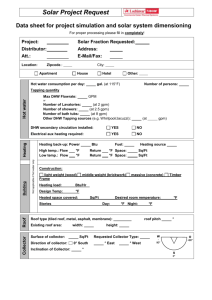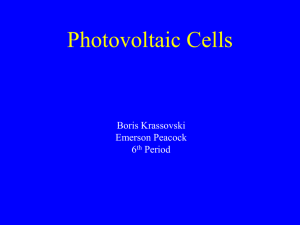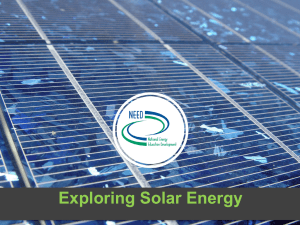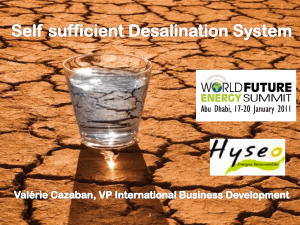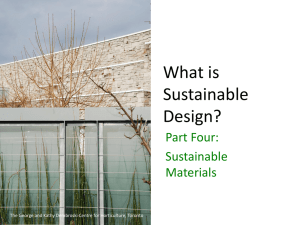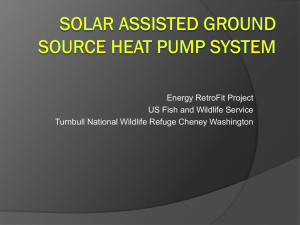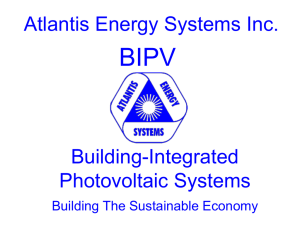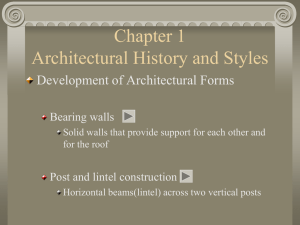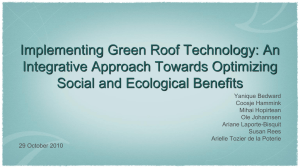PLUS ENERGY HOUSE
advertisement
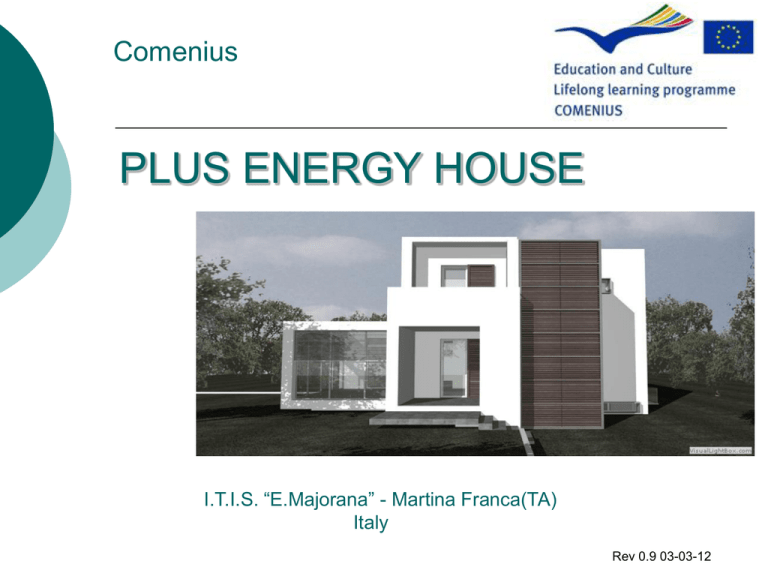
Comenius PLUS ENERGY HOUSE I.T.I.S. “E.Majorana” - Martina Franca(TA) Italy Rev 0.9 03-03-12 Comenius Multilateral school partnership 2011-1-DE3-COM06-19211-5 PLUS ENERGY HOUSE 2° project meeting Sneek, Netherlands 6-10 March 2012 Partner of project Berufsbildende Schulen des Landkreises Osnabrück in Bersenbrück, Germany Egressy Ga'bor Ke'ttannylvü Müszaki Szakköze'piskola, Budapest, Hungary Oguzeli Cok Programli Lisesi, Gaziantep, Turkey ZSP Somonino, Somonino, Poland ROC Friese Poort Sneek, Sneek, Netherlands Spojená škola, Prešov, Slovakia ITIS "E. Majorana", Martina Franca (TA), Italy Plus energy house as a green building \ A Plus Energy House is essentially a passive house with a low level of energetic consumption, class A+, integrated with electric energy production plants from renewable sources that allow a complete energetic autonomy. Sometimes these plants are also able to produce a surplus of energy. We would like to propose a model of Plus Energy House which meets the 10 rules of modern green architecture. 10 RULES FOR A MODERN GREEN ARCHITECTURE 1. Build respecting the typical architecture of the territory 2. Take in account the exposure, orientation and natural daylight 3. Use Eco-friendly materials 4. Ensure Impermeability and breathability 5. Ensure Thermal insulation 6. Low energy demand 7. Energetic autonomy 8. Water autonomy 9. An Autonomous system of household waste disposal 10. Automation and comfort 5 PLUS ENERGY HOUSE Examples House of Southern Country 7 House of Southern Country Example of a modern bio-architecture, well integrated in a southern climatic contest. It has a flat roof, white colour and large windows.The 10kWp photovoltaic system is integrated in the building and consists of photovoltaic sheets in amorphous silicon that cover the entire roof and of monocrystalline silicon panels located on the south facade. The air conditioning system uses geothermal heat pumps. 9 House of Northern Country House of Northern Country Example of a modern bio-architecture, well integrated in a northern or mountain climatic contest. It has a sloping roof, dark coating and large windows facing on the roof. The photovoltaic system is integrated in the sloping roof and consists of photovoltaic sheets and tiles in amorphous silicon. In the roof are also incorporated solar collectors for hot water and heating. 12 1.The typical architecture of the territory A low environmental impact construction A low environmental impact construction must fit into the landscape without altering it, respecting the natural shape of the terrain, existing vegetation, the typical architecture, and the use of local materials 1.The typical architecture of the territory The trullo The trullo is a building typical of Puglia. It has a conical roof made of local limestone without the use of concrete. The walls are thick and conical roof is covered with slabs of stone called "chiancarelle". It 's usually used at home for summer holidays of 4 or more rooms, and its shape provides a natural thermal insulation. 1.The typical architecture of the territory The houses with vaulted roofs The curved roof buildings are usually used as barns, warehouses, stables .Externally, the barrel vault is left exposed and covered with stone slabs. The outer walls are slightly inclined and painted with lime. For their construction local stone without the use of concrete is used. 1.The typical architecture of the territory The houses with plan roofs The houses with flat roofs are formed by two or four rooms with vaulted ceilings. The outer walls are slightly inclined and painted with lime. For their construction they use local stone without the use of concrete. 1.The typical architecture of the territory The houses with sloping roofs The houses with sloping roofs are made of stone and have rooms with vaulted covered externally with chiancarelle as in the trulli. They are typical of the farms and houses in the historic center. For their construction local stones without the use of cement are used. 2. Exposure, orientation and natural daylight a)Passive House Concept b)Solar energy - Radiation and shading c)Natural ventilation and cooling d)The use of colours in wall coverings e)Exposition and surfaces of the windows. f)Energy saving lighting. Passive House Concept The passive house is a house which ensures thermal comfort without any conventional heating; It exploits the sunlight the ground heat and the natural ventilation. It is realised with special construction techniques, the use of appropriate materials, the correct orientation. It has an energy requirement of less than 14 kWh / sqm. Solar energy - Radiation and shading Natural ventilation and cooling The house uses passive solar radiation for heating in winter, vegetation and winds to cool in the summer, the heat exchange with the soil to maintain a constant internal temperature The use of colours in wall coverings Exposition and surfaces of the windows. Energy saving lighting. In hot climates the houses are painted in white colour to absorb less solar radiations, while in the nordic countries dark colours are used to absorb more radiations. A correct position of the rooms and windows can save on the artificial heating, exploiting the effects of the light and the solar heating. 3. Eco-friendly materials a) Km 0 Natural material b) No harmful emissions c) Recyclable or biodegradable materials. d) The life cycle of a building e) Eco-balance 3.Eco-friendly materials The plus energy house is made of enviromentally-friendly materials locally available : limestone, clay, wood. The use of glass, metal and of other recyclable materials is also allowed . The use of artificial products, especially plastic, must be minimized, as well as those derived by oil that often emanate harmful substances. However, natural materials are not always also environmentally friendly. Life cycle of a building The environmental impact of a building must be analyzed taking into account the life cycle of building materials consisting of the following phases: - extraction: - production of the material - manufacturing and installation - permanence of building materials - removal, demolition, disposal and recycling Eco-balance . The eco-balance quantifies the effects of the complete life cycle of a building on humans and the environment and takes account of: - Consumption of raw material - Consumption of energy - Environmental pollution - Waste and recycling - Economic and social aspects. 4. Impermeability and breathability The house must be protected by the rainwater infiltration with roofs that can be flat, sloping, at dome, at cone and at archway. In the old roofs and in the trulli the impermeability is assured by the correct disposition of tiles and ‘chiancarelle’. The ground floors must be protected by interspaces and crawl spaces. 5.Thermal insulation The coating of a building must have a high resistance to the passage of heat, which is usually obtained by interposing thick layers of insulating material between two layers of masonry of hollow bricks. The insulation depends on the thickness of the insulating layer . Wood is an excellent insulating material. Thermal insulation of the roof Heat transmission and thermal conductivity of materials Thermal insulation of the exterior walls Thermal insulation of the ground floor Types of window frames and thermal performance PVC Wood Aluminum Wood-aluminum The windows should ensure the passage of solar radiation for lighting and space heating. There must be double or triple paned, insulating airtight frames, shutters or blinds. Wood window frames are preferred to those of aluminum and PVC. 6.Low energy demand Criteria for calculating energy requirements To calculate the energy requirement you need to consider thermophysical characteristics of the building, of the type of the plan, of the orientation and of the enivironmental climate. The calculation is made with appropriate software. To save energy it is fundamental to exploit the sun's energy intake, and the heat intake of household appliances and of the people living in the house. Energy class and building legislation 7. Energetic autonomy a) Air conditioning and heating. b) Geothermal energy and heat pumps c) Solar collectors for hot water production d) Photovoltaic systems e) Electrical energy storage systems and hydrogen fuel cells Air conditioning and heating The air-conditioning of the building is in a natural way, using the convection of air between two parts of the building at different temperatures (see figure). The internal heating is of the type at low temperature, with radiant floor heated by geothermal heat pumps and solar collectors, which also provide hot water for sanitation . The photovoltaic plant converts solar radiation into electricity by exploiting some properties of semiconductors. They can be off-grid (stand alone), with electrical energy storage system or can be with connected grid, in which case the energy that is not consumed is fed into the grid. Wind power plants transform the kinetic energy of the wind into electric energy. They are constituted by a wind turbine, by an alternator, a supporting post, by a charge controller and an inverter. As well as the wind turbines they can stand alone and be grid connected. In domestic systems they are often combined with a photovoltaic system. Photovoltaic rigid panels: high efficiency but difficult architectural infill Amorphous silicon: low efficiency but easy architectural infill Electrical energy storage systems and fuel cells of hidrogen The fuel cell uses hydrogen as a fuel. Hydrogen is produced by the decomposition of water with energy from the photovoltaic system and produces only water as exhaust gas. The fuel cell replaces conventional electric energy storage (lead highly polluting). 8. Water autonomy Rainwater collected from roofs: if properly purified it can be used indoors for systems without wasting drinkable water. 9. Autonomous systems of household waste disposal The house also relates to sustainable systems of autonomous household waste disposal as far as concerns: a. Wastewater treatment plants b. Composting plants Wastewater traetment plants Purification of waste water can be performed with a water purification system consisting of an Imhoff tub, a second settling tank and an underground drainage tube and trees that absorb water; excess water is sent to the second tank, and finally retracted and pumped back into the soil. Home composting Composting is an aerobic biological process, starting from our organic kitchen waste and vegetables; it leads to the production of compost, which is a useful product to fertilize the soil. Home composting is aided by appropriate collection systems and storage products. 10. Automation and comfort Home automation allows savings through the intelligent control of the following systems: - Separate single-room air conditioning - Automatic switching on and off of the lights - Decommissioning facilities in each room in case of opening of windows and exterior doors - Management of the heating time - Timing of appliances - Automatic rolling shutters and awnings, depending on solar radiation. Measuring Parameters of Home Comfort Indoor comfort is defined as the particular condition of wellness given by temperature, humidity, noise and light level of the environment and sensorially perceived by the people who stay in a house. Therefore, the measurable parameters of home comfort are: - Termo–hygrometric wellness - Acoustic Comfort - Lighting wellness THANK YOU FOR YOUR ATTENTION!! Students: Debora GORINI Laura RUBINO Angelo NOTARNICOLA Francesco LATERZA Headmistress Prof.ssa Anna Ausilia CAROLI Teachers: Prof.ssa Angela ENTRINGER Prof.ssa Vitantonia LADDOMADA Prof. Vito COLUCCI Prof. Stefano PALASCIANO http://www.majorana.martina-franca.ta.it

